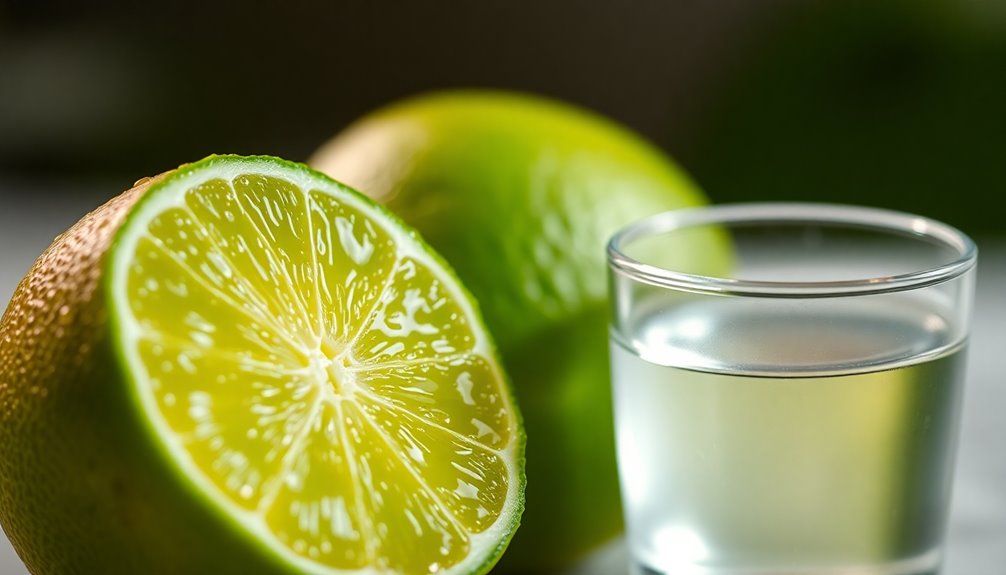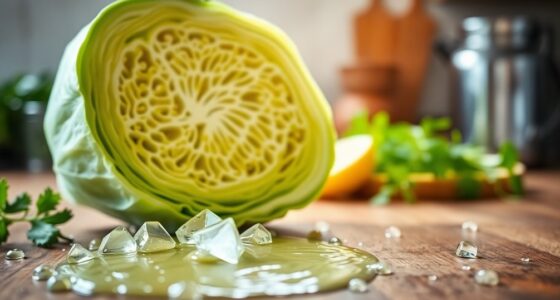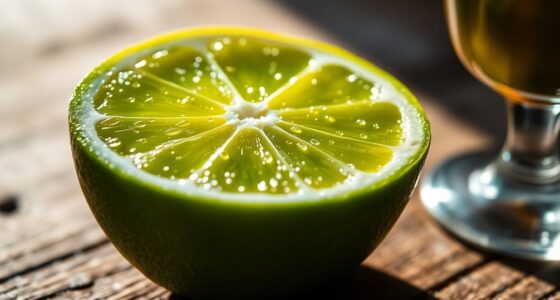One medium lime typically yields about 2 tablespoons of juice, which is perfect for your cooking and cocktail needs. If you only have half a lime, you'll get around 1 tablespoon of juice. To maximize your yield, choose firm, ripe limes and apply some pressure while squeezing. It's always a good idea to have a few extras on hand, just in case. Discover more tips for using lime juice effectively to enhance your dishes.
Key Takeaways
- One medium lime typically yields about 2 tablespoons (1 ounce) of juice.
- Half a lime produces approximately 1 tablespoon (1/2 ounce) of juice.
- Firm and ripe limes yield more juice than lighter, less ripe ones.
- Rolling the lime before cutting enhances juice extraction.
- Always have extra limes for recipes to account for any miscalculations.

When you squeeze one medium lime, you can expect to get about 2 tablespoons of juice, or roughly 1 ounce. This juice yield is fairly consistent, so when you're planning your recipes, knowing how much juice you can extract from limes is essential. If you're aiming for that fresh lime juice flavor in your dishes or cocktails, understanding the amount of juice you get from one lime can help you avoid any last-minute surprises.
If you need 1/4 cup of lime juice for a recipe, you'll require about 2 limes. That means you'll get about 4 tablespoons of lime juice from the two limes, giving you just enough for that zesty punch in your favorite dish. It's always a good idea to have a couple of extra limes on hand just in case you miscalculate the amount or if the limes you pick aren't as juicy as expected.
When you're preparing to cut the lime, make sure you choose firm, heavy limes. These limes tend to be more ripe and yield more juice compared to their lighter, less ripe counterparts. You might find that selecting the right limes can make a significant difference in the amount of juice you get.
A half lime typically produces around 1/2 ounce of juice or approximately 1 tablespoon of lime juice. So, if you only need a small amount for a recipe or a drink, just cutting one lime in half could be sufficient. When considering how much juice in half a lime you’ll get, it’s good to know that the yield can vary slightly depending on the lime’s size and freshness. For recipes requiring a bit more acidity or flavor, you can always squeeze the juice from the other half if needed. This makes half a lime a versatile option for enhancing beverages and dishes without having to use an entire fruit.
To maximize your juice yield, roll the lime on the countertop before cutting it. This action helps to break down the inner membranes and can make it easier to extract juice. Once you cut the lime, you can use a manual juicer or simply squeeze it by hand to get that fresh lime juice flowing. Remember, the key is to apply pressure and twist as you extract the juice.
If you're using limes for cocktails, salads, or marinades, you'll quickly notice how vital the amount of lime juice can be for balancing flavors. The acidity of the lime juice can elevate your dishes, and knowing how many limes to use is crucial for achieving the desired taste.
Frequently Asked Questions
Can I Substitute Bottled Lime Juice for Fresh Lime Juice?
You can substitute bottled lime juice for fresh lime juice, but keep in mind that the flavor won't be as vibrant.
Fresh lime juice has a brightness that bottled juice lacks due to pasteurization. If you're in a pinch, use about 1 tablespoon of bottled juice for every tablespoon of fresh juice.
However, for recipes that highlight lime, like key lime pie, you should stick to fresh for the best taste.
How Much Juice Does a Lime Make?
When you squeeze a lime, it's like unlocking a treasure chest of flavor!
Typically, you'll get about 2 tablespoons, or 1 ounce, of juice from one medium lime. This makes it easy for you to figure out how many limes to buy for your recipes.
If you're aiming for a quarter cup, just grab two limes. Rolling them on the countertop first can help you get every last drop of that zesty goodness!
How Much Juice Is in One Key Lime?
When you squeeze one key lime, you can expect to get about 1 tablespoon of juice.
These limes are smaller and rounder than regular limes, which contributes to their lower yield. Their unique, floral flavor makes them perfect for dishes like Key lime pie.
If you're juicing multiple key limes, remember that it takes about 20 to get half a cup of juice, so plan accordingly for your recipes!
How Much Lime Juice Concentrate for 1 Lime?
Using lime juice concentrate is like swapping fresh flowers for a silk arrangement; it's convenient but different.
For one medium lime, you'll need about 1 tablespoon of lime juice concentrate. This substitution works well in recipes, but remember, the flavor mightn't be the same as fresh juice.
Always check the label for any added preservatives or sugars that could change the dish's overall taste.
Enjoy your cooking!
Conclusion
So, next time you grab a lime, remember it's not just a small green fruit; it's a citrus powerhouse! You can squeeze out about 2 tablespoons of juice, enough to transform your drink from blah to WOW! Imagine the zesty explosion in your mouth, brightening up your tacos and guacamole like a fireworks show! Don't underestimate that little lime—it's like a tiny, tangy magician ready to make your recipes pop with flavor! Citrus magic awaits!
Cindy thoroughly researches juicing trends, techniques, and recipes to provide readers with practical advice and inspiration. Her writing style is accessible, engaging, and designed to make complex concepts easy to understand. Cindy’s dedication to promoting the advantages of juicing shines through her work, empowering readers to make positive changes in their lives through the simple act of juicing.

















